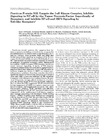| dc.contributor.creator | Stack, Julianne | |
| dc.contributor.creator | DiPerna, Gary | |
| dc.contributor.creator | Bowie, Andrew G. | |
| dc.contributor.creator | Boyd, Annemarie | |
| dc.contributor.creator | Kotwal, Girish | |
| dc.contributor.creator | Zhang, Zhouning | |
| dc.contributor.creator | Arvikar, Sheila | |
| dc.contributor.creator | Latz, Eicke | |
| dc.contributor.creator | Fitzgerald, Katherine A. | |
| dc.contributor.creator | Marshall, William L. | |
| dc.date.accessioned | 2019-02-26T12:40:28Z | |
| dc.date.available | 2019-02-26T12:40:28Z | |
| dc.date.issued | 2004 | |
| dc.identifier.citation | DiPerna, G. et al. (2004) Poxvirus protein N1L targets the I-kB kinase complex, inhibits signaling to NF-kB by the tumor necrosis factor superfamily of receptors, and inhibits NF-kB and IRF3 signaling by toll-like receptors. J Biol Chem. 279(35): 36570-8. | en_US |
| dc.identifier.uri | http://hdl.handle.net/10395/2679 | |
| dc.description | Poxvirus protein N1L targets the I-kB kinase complex, inhibits signaling to NF-kB by the tumor necrosis factor superfamily of receptors, and inhibits NF-kB and IRF3 signaling by toll-like receptors. | en_US |
| dc.description.abstract | Poxviruses encode proteins that suppress host immune responses, including secreted decoy receptors for pro-inflammatory cytokines such as interleukin-1 (IL-1) and the vaccinia virus proteins A46R and A52R that inhibit intracellular signaling by members of the IL-1 receptor (IL-1R) and Toll-like receptor (TLR) family. In vivo, the TLRs mediate the innate immune response by serving as pathogen recognition receptors, whose oligomerized intracellular Toll/IL-1 receptor (TIR) domains can initiate
innate immune signaling. A family of TIR domaincontaining adapter molecules transduces signals from engaged receptors that ultimately activate NF- B and/or interferon regulatory factor 3 (IRF3) to induce proinflammatory cytokines. Data base searches detected a significant similarity between the N1L protein of vaccinia virus and A52R, a poxvirus inhibitor of TIR signaling.
Compared with other poxvirus virulence factors, the poxvirus N1L protein strongly affects virulence in vivo; however,
the precise target of N1L was previously unknown. Here we show that N1L suppresses NF- B activation following
engagement of Toll/IL-1 receptors, tumor necrosis factor receptors, and lymphotoxin receptors. N1L inhibited receptor-, adapter-, TRAF-, and IKK- and IKK- -dependent signaling to NF- B. N1L associated with several components of the multisubunit I- B kinase complex, most strongly associating with the kinase, TANK-binding kinase 1 (TBK1). Together these findings are consistent with the hypothesis that N1L disrupts signaling to NF- B by Toll/IL-1Rs and TNF superfamily receptors by targeting the IKK complex for inhibition. Furthermore, N1L inhibited IRF3 signaling, which is also regulated by TBK1. These studies define a role for N1L as an immunomodulator of innate immunity by targeting components of NF- B and IRF3 signaling pathways. | en_US |
| dc.language.iso | eng | en_US |
| dc.publisher | ASBMB [American Society for Biochemistry and Molecular Biology] | en_US |
| dc.relation.ispartofseries | 279;35 | |
| dc.rights.uri | http://www.jbc.org/content/279/35/36570.full | en_US |
| dc.subject | Poxvirus protein | en_US |
| dc.subject | N1L | en_US |
| dc.subject | I-kB kinase complex | en_US |
| dc.subject | NF-kB | en_US |
| dc.subject | Tumor necrosis factor | en_US |
| dc.subject | Superfamily | en_US |
| dc.subject | Receptors | en_US |
| dc.subject | IRF3 | en_US |
| dc.subject | Toll-like receptors | en_US |
| dc.title | Poxvirus protein N1L targets the I-kB kinase complex, inhibits signaling to NF-kB by the tumor necrosis factor superfamily of receptors, and inhibits NF-kB and IRF3 signaling by toll-like receptors | en_US |
| dc.type | Article | en_US |
| dc.type.supercollection | all_mic_research | en_US |
| dc.type.supercollection | mic_published_reviewed | en_US |
| dc.description.version | Yes | en_US |
| dc.identifier.doi | 10.1074/jbc.M400567200 | |


